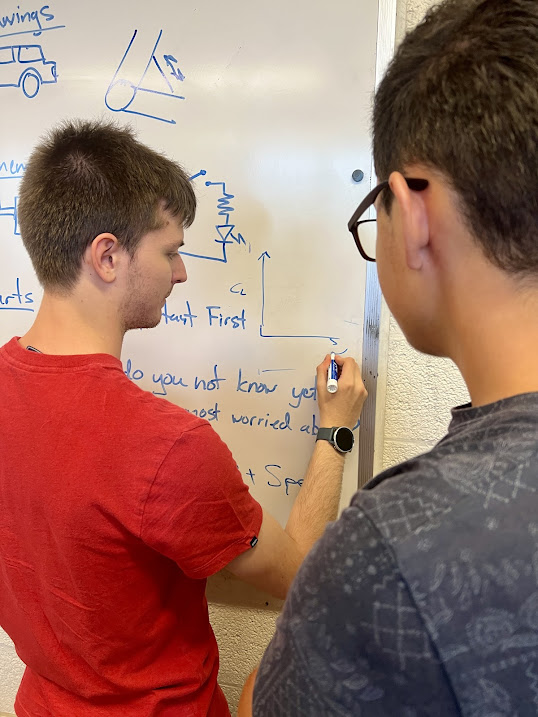Introduction
We are moving away from the part of the program where we tell you what to do and entering the phase where you tell us what you need. You now have your project groups, and we've brought in a bunch of mentors. Some mentors will be floating around, while others will stay specifically with your group. Today, I want you to focus on several key tasks.
Drawings and Schematics
First, I want you to think about creating drawings and schematics. These terms can mean different things to different people. I'd like you to define what you think a drawing and a schematic are. For instance, a blueprint could be considered either a drawing or a schematic. Personally, I view it more as a drawing.
A drawing provides a rough view of what the whole thing looks like, while a schematic shows how it works. For example, a drawing might lack dimensions, but a schematic could include an exploded view showing all internal parts.
Clarifying Concepts
I don't need dictionary definitions. I want your understanding of what these terms mean. A drawing can help us visualize what you've been working on, while a schematic helps in thinking about all the parts needed to make it work. If we start drawing electronic schematics, we can discuss what they look like and what the different symbols mean.
Parts List
After completing your drawings, the next task is to compile a parts list. We'll share a link to a parts ordering form where you'll list what you need, the quantity, and the cost. A mentor will sign off on your parts list to ensure you're ordering useful items, and then I'll purchase them.
During the summer, Amazon will be a crucial resource due to fast shipping and a special deal MIT has with them, making parts cheaper. Time is your enemy when ordering parts, so avoid items that take more than a couple of days to arrive.
Skills and Challenges
We also need to know what skills you lack and need to learn for your project. Whether it's soldering, coding Arduino, understanding how planes work, etc., we can direct you to the right mentors. Additionally, tell us your biggest worries and what you consider the linchpin of your project that could cause issues if not handled correctly.
Team Name
Lastly, choose a team name. At some point, I’ll need to address you by your team name instead of descriptions like "dancing robot people." Make sure everyone understands the tasks for today. Start at the top and work your way down the board.
Conclusion
Alright, does everyone understand what we're going to do today? If so, let's get started.
Introducción
Estamos pasando de la parte del programa donde les decimos qué hacer a la fase donde ustedes nos dicen qué necesitan. Ahora tienen sus grupos de proyecto, y hemos traído a un montón de mentores. Algunos mentores estarán circulando, mientras que otros se quedarán específicamente con su grupo. Hoy quiero que se enfoquen en varias tareas clave.
Dibujos y Esquemas
Primero, quiero que piensen en crear dibujos y esquemas. Estos términos pueden significar cosas diferentes para distintas personas. Me gustaría que definan lo que piensan que es un dibujo y un esquema. Por ejemplo, un plano podría considerarse tanto un dibujo como un esquema. Personalmente, lo veo más como un dibujo.
Un dibujo proporciona una vista general de cómo se ve todo, mientras que un esquema muestra cómo funciona. Por ejemplo, un dibujo podría no tener dimensiones, pero un esquema podría incluir una vista explotada que muestre todas las partes internas.
Clarificación de Conceptos
No necesito definiciones de diccionario. Quiero su comprensión de lo que significan estos términos. Un dibujo puede ayudarnos a visualizar en qué han estado trabajando, mientras que un esquema ayuda a pensar en todas las partes necesarias para que funcione. Si comenzamos a dibujar esquemas electrónicos, podemos discutir cómo se ven y qué significan los diferentes símbolos.
Lista de Piezas
Después de completar sus dibujos, la siguiente tarea es compilar una lista de piezas. Compartiremos un enlace a un formulario de pedido de piezas donde enumerarán lo que necesitan, la cantidad y el costo. Un mentor firmará su lista de piezas para asegurarse de que están ordenando artículos útiles, y luego las compraré.
Durante el verano, Amazon será un recurso crucial debido a su envío rápido y un acuerdo especial que tiene el MIT con ellos, haciendo que las piezas sean más baratas. El tiempo es su enemigo al ordenar piezas, así que eviten artículos que tarden más de un par de días en llegar.
Habilidades y Desafíos
También necesitamos saber qué habilidades les faltan y necesitan aprender para su proyecto. Ya sea soldar, programar Arduino, entender cómo funcionan los aviones, etc., podemos dirigirlos a los mentores adecuados. Además, cuéntennos sus mayores preocupaciones y lo que consideran el punto clave de su proyecto que podría causar problemas si no se maneja correctamente.
Nombre del Equipo
Por último, elijan un nombre para el equipo. En algún momento, necesitaré dirigirme a ustedes por su nombre de equipo en lugar de descripciones como "gente del robot bailarín". Asegúrense de que todos entiendan las tareas de hoy. Comiencen por la parte superior y vayan avanzando por la lista.
Conclusión
Bien, ¿todos entienden lo que vamos a hacer hoy? Si es así, empecemos.




















No comments:
Post a Comment